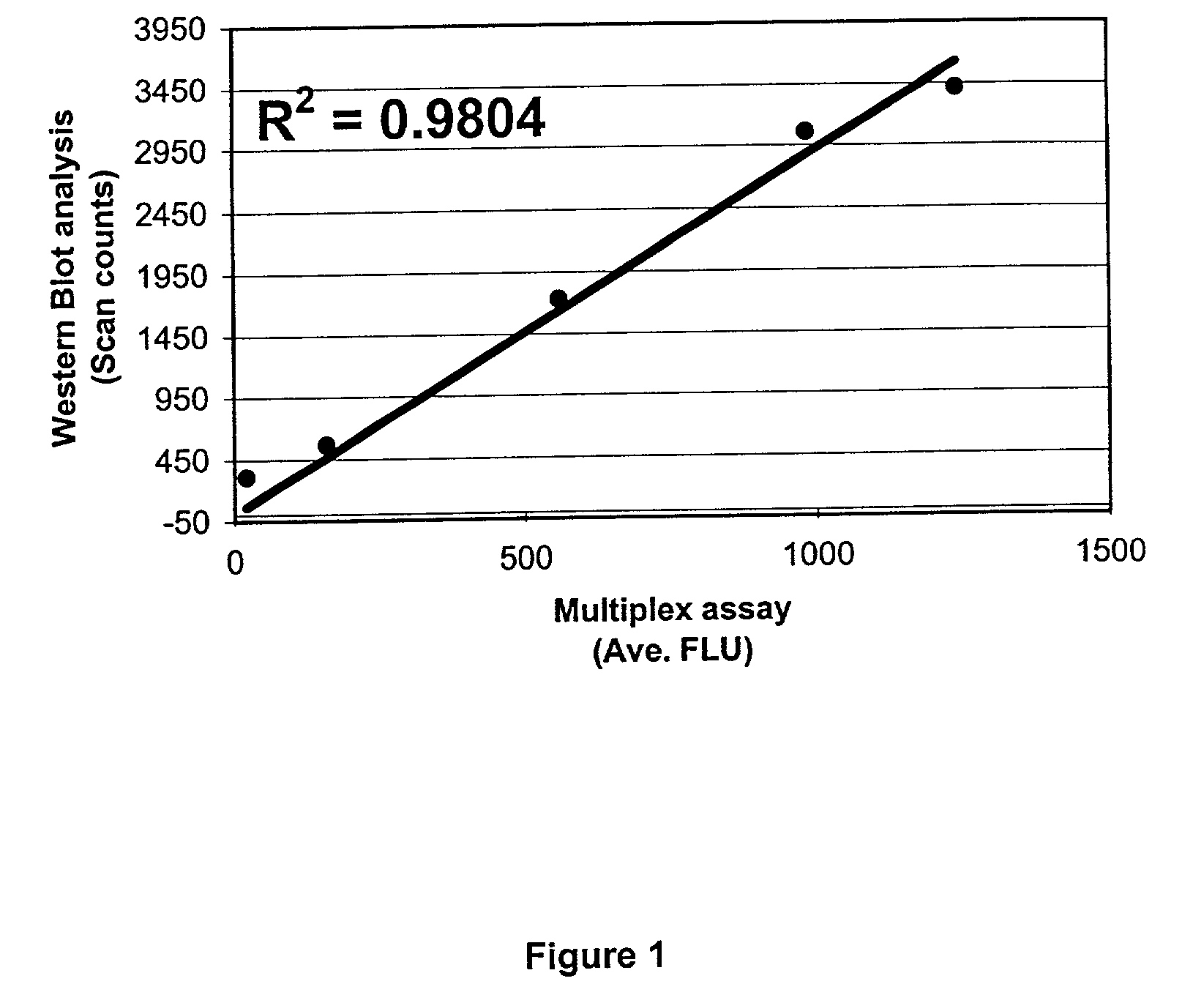Assay system for simultaneous detection and measurement of multiple modified cellular proteins
a technology of cellular protein and detection system, which is applied in the field of simultaneous detection and measurement of multiple modified cellular proteins, can solve the problems of limited detection and measurement of such modified proteins, as currently carried out, and determine one analyte, and achieve the effect of reducing the number of steps
- Summary
- Abstract
- Description
- Claims
- Application Information
AI Technical Summary
Problems solved by technology
Method used
Image
Examples
example 1
[0049]The following represents an example of a kit of this invention, and of a process for simultaneously determining multiple phosphorylated proteins in a sample.
[0050]A kit is prepared containing the following:
[0051]Phosphoprotein Assay (Detection Modules)[0052]Capturing antibody-conjugated beads (50×, 250 μl)[0053](Each analyte=2.5×106 beads / mL)
Phosphoprotein Detection Antibody (antiphosphortyrosine from SIGMA Chemical—clone PY54)[0054]50× for Premixed Multi-Plex Assays (120 μl)[0055]100× for Unmixed Multi-Plex Assays (70 μl each analyte)[0056](each Detection Antibody=0.2 mg / mL)[0057]Positive Controls for phospho-JNK and phospho-p38MAPK[0058](250 μl / vial at 200 μg / ml)[0059]Positive control for phosphoproteins (250 μl / vial at 200 μg / ml, per protein).[0060]Negative control (250 μl / vial at 200 μg / ml protein)
[0061]Cell Lysis Kit A[0062]Cell Wash Buffer A (1×, 150 ml) (20 mM Tris-HCl, pH 7.35–7.45, 0.9% NaCl)[0063]Cell Lysis Buffer A (1×, 25 ml) (20 mM Tris-HCl, pH 7.8–8.2, 50–500 mM ...
example 2
Assay for Multiple Modified Proteins
[0093]The above procedure was used to simultaneously analyze a sample of cell lysates containing five phosphorylated proteins: phosphorylated p38MAPK, IκBα, Erk2, JNK and Akt1. The proteins were phosphorylated at the following sites: p38MAPK-Thr180, Tyr182; IκBα-Ser32, Ser36; Erk2-Thr202, Tyr204; JNK-Thr183, Tyr185; Akt1-Ser473. Cell lysates were HeLa and HEK-293 simulated with UV, EGF, Fetal Bovine Serum (FBS) or TNF-alpha. The uninduced HeLa cell lysate was also prepared and used as a negative control. All procedures were done on a 96-well filter plate. The cell lysate samples were analyzed by the above procedure and verified for expression of phosphorylated proteins via Western blotting. The result demonstrates: (1) a simultaneous detection of all five phosphorylated proteins above; (2) only 5–10 μg of cell lysate per well was needed for the analysis; (3) an inter-plate and intra-plate coefficient of variation less than 10% and (4) a tight quan...
PUM
| Property | Measurement | Unit |
|---|---|---|
| temperature | aaaaa | aaaaa |
| temperature | aaaaa | aaaaa |
| temperature | aaaaa | aaaaa |
Abstract
Description
Claims
Application Information
 Login to View More
Login to View More - R&D
- Intellectual Property
- Life Sciences
- Materials
- Tech Scout
- Unparalleled Data Quality
- Higher Quality Content
- 60% Fewer Hallucinations
Browse by: Latest US Patents, China's latest patents, Technical Efficacy Thesaurus, Application Domain, Technology Topic, Popular Technical Reports.
© 2025 PatSnap. All rights reserved.Legal|Privacy policy|Modern Slavery Act Transparency Statement|Sitemap|About US| Contact US: help@patsnap.com

